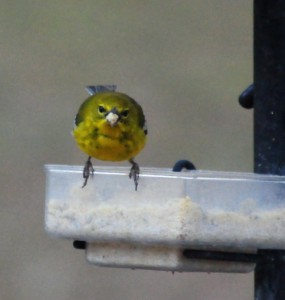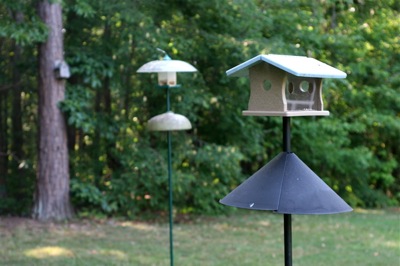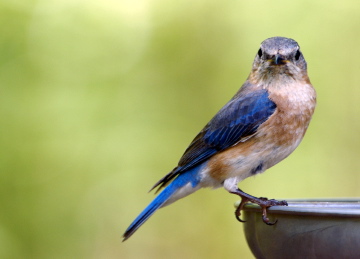- Bird Accessories, Bird Feeders, Birding Accessories, Bluebird Feeders, Fruit, Jelly & Mealworm Feeders, Mealworm Feeder, Uncategorized, Wild Bird Feeders
The dish style mealworm feeder offers various feed options
Hey lady! What’s up with the Mealworm Feeder?
This little plexiglass dish get big traffic in our yard! When live mealworms are placed in it (most times twice a day) all bets are off. The bird traffic is fast and furious, first come, first served!
Originally meant for our Bluebirds – the Chickadees and Titmice quickly learned of the treasure. So, the Bluebirds soon received their own enclosed mealworm feeder, although Carolina Wrens have since figured that out as well!
Feeding live worms can get expensive when everybody’s in on the coveted treat, and I mean everybody! Even the Robins get a few worms in a glass dish that’s left on the ground. And I can’t stand when the crows get to them first!
Unless you have the time and patience to cultivate your own worms, ordering in bulk quantities is easier on the wallet. The worms really aren’t that expensive… it’s the shipping that gets ya! Since they’re live, overnight delivery is required for warmer temperatures. For a few months out of the year (depending on your location) a second-day delivery works fine.
Gradually decreasing the amount of worms, and adding a home-made suet mixture in this meal worm feeder landed a “so-so” reaction from most of our beaked buddies. This Pine Warbler has a mouthful of the stuff, (which is why his beak looks fat & white) but just look at that expression! It’s like “excuse me, where are my worms?”
This mealworm dish actually has drainage, but many similar styles do not, making them perfect for offering water too. In summer, fresh fruit is a great choice for migratory birds, while suet mixtures & crumbles, and shelled peanuts are good options for cold weather feeding.
Offering live worms has created a whole new dimension to our backyard birding experiences. Definitely worth giving it a try if you’ve never fed them before, especially if bluebirds are in the area. And Robins adore them too! But if you don’t want the birds eating you out of house and home… a more traditional, or enclosed mealworm feeder may be your better choice.
- Bird Accessories, Bird Feeders, Bluebird Feeders, Fruit, Jelly & Mealworm Feeders, Live Meal Worms, Mealworm Feeder, Uncategorized
nasty yellow jackets at the mealworm feeder
Lots of bluebirds have passed through this mealworm feeder in our back yard. Last season we had three successful broods of Eastern Bluebirds, in part, thanks to a welcoming habitat. Even the Chickadees, Carolina Wrens and Titmice have learned to use this fly-in mealworm feeder with ease… which I’m not sure is such a good thing? Worms are really reserved for our bluebirds only! This traditional type bluebird feeder is made from recycled plastic, and although it’s about five years old now, it still looks and acts the same way as when it was first installed. With so much junk out there, who doesn’t like quality stuff!
What I am sure of that’s not a good thing are the yellow jackets who continue to torture the live worms inside the feeder! When, for heaven’s sake is it time for them to die off? Every morning when I go to add worms for the patiently waiting, eager bluebirds… the yellow jackets are in there munching on worm remains.
Last night it was in the 20’s here in North Georgia, and finally this morning none of the nasty jax were seen! The weather here is crazy though, hot, cold, warm cold, even some bulbs started forcing their way through the ground with the last dip in temperatures.
I can only hope with this last frost, that all yellow jackets are gone for the season! I think the birds will be happy too 🙂
- Bird Accessories, Bird Feeders, Bluebird Feeders, Fruit, Jelly & Mealworm Feeders, Live Meal Worms, Mealworm Feeder, Uncategorized
Try a Mealworm Feeder for Bluebirds
In order to entice bluebirds, sometimes their very favorite food must be offered. And meal worms happen to be what’s on the menu over here. Live mealworms are best, but dried or roasted ones will also work. One of the problems is that many species really enjoy mealworms, and you can find your supply dwindling quickly if fed in an open tray-type or dish feeder. Live mealworms are available in bulk quantities should this become habit forming too. They’re simple to store…just place in in a container in your fridge. Air holes are needed, but the worms stay in a dormant state until warmed up by the sun or room temperatures.
A mealworm feeder that’s made especially for bluebirds is one that is enclosed, in fact they’re called Bluebird Feeders. Consisting of two, four, or sometimes six entrances, they have clear acrylic panels for closures, and they’re meant for bluebirds only. Some feeders have a dish in the center for the worms, while others have a recessed circle for them. The birds must fly into the feeder to retrieve the worms, and very few species will try this. But somehow, the natural instinct of bluebirds tells them to do so.
It’s amazing to watch, especially when parent bring babies over at feeding time. At first the chicks don’t understand how to get inside, but they learn quickly. And once they learn how to get the food, they frequent the feeder often. This has got to be one of the best scenes of backyard birding!
Available in standard wooden models, mealworm feeders also come in recycled plastic versions. The advantage with
recycled plastic is that the feeder will never crack, split, or rot like wood tends to do over the years. Also keeping plastics out of landfills is huge plus to the environment.
Now I wish the nasty starling who tried to shove himself through one of the entrances would’ve gotten stuck there!





